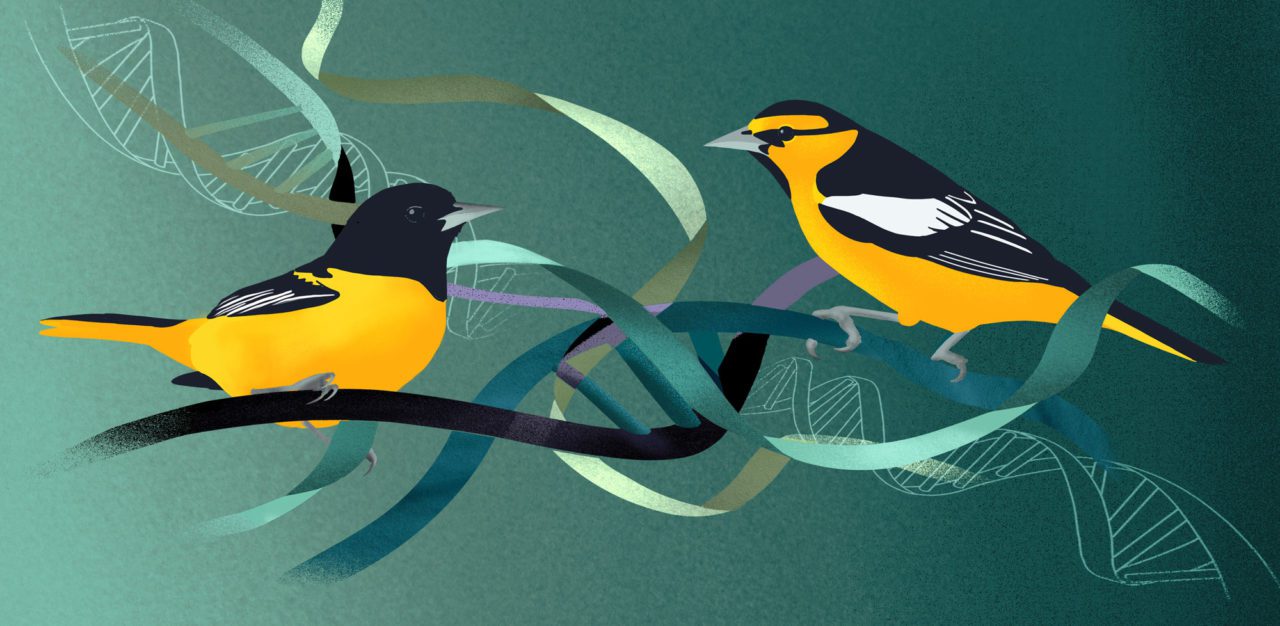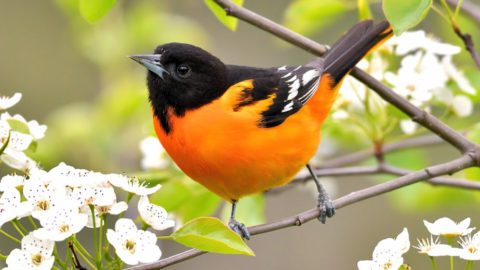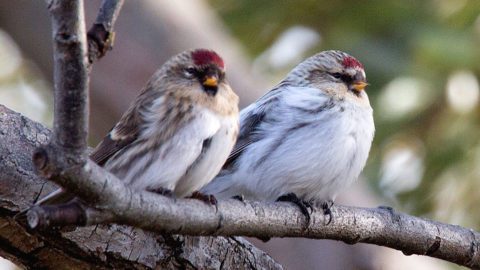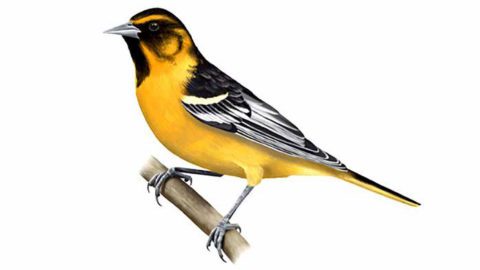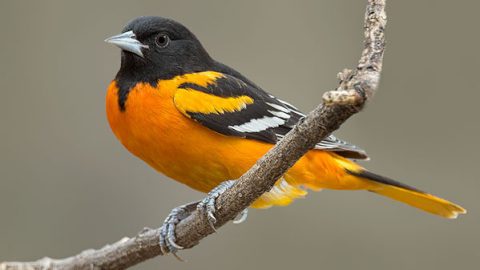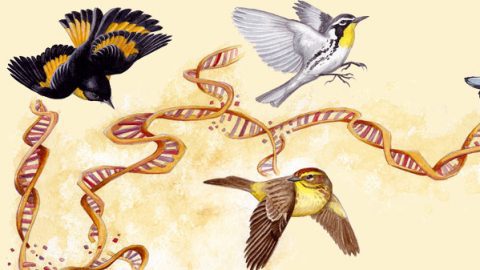A Deep Dive into the Oriole Genome Tackles the Mystery of Hybridization
Using the latest genome-mapping technology, a team of Cornell Lab of Ornithology evolutionary biologists set out to settle a decades-long debate—are Baltimore and Bullock’s Orioles two species, or one? Five years later the team got their answer—and in doing so, unlocked a new set of questions.
By Rebecca Heisman
April 4, 2022From the Spring 2022 issue of Living Bird magazine. Subscribe now.
Between the Mississippi River and the Rocky Mountains lies the open expanse of the Great Plains, originally a grassland ecosystem dominated by fire and bison. Today the bison are all but gone, the fires have been suppressed, and much of the grass has been plowed up and replaced by agriculture. Yet the Great Plains still form an ecological barrier between the forests of the eastern and western United States—and their bird populations.
On either side of the Plains live eastern and western birds that are related, but diverged into separate species a long time ago. And they remain separated by the lack of forest habitat between them, except for the cottonwood corridors along rivers such as the Niobrara, the Platte, and the Red—wooded highways that allow forest birds from the East and West to venture onto the otherwise inhospitable plains. There, the birds meet and occasionally mate with their distant cousins. Indigo and Lazuli Buntings, Eastern and Spotted Towhees, Rose-breasted and Black-headed Grosbeaks: All of these eastern-and-western complementary pairs of bird species can hybridize when they encounter each other, sometimes producing fertile offspring and confusing generations of birdwatchers and ornithologists trying to sort out where one species ends and another begins.
One of these species pairs, the Bullock’s Oriole and the Baltimore Oriole, has proved more vexing than most. Lumped in the 1970s as a single species called the Northern Oriole, they were re-split in 1995 by the American Ornithologists’ Union when further studies showed they were more different than previously believed. To solve the riddle of their relationship, a team of scientists at the Cornell Lab of Ornithology recently finished sequencing the entire genomes of more than 60 orioles, including pure individuals of both Bullock’s and Baltimores and a range of hybrids in between. The research effort married 21st-century genomics with 1950s-era specimen collecting, using the latest sequencing technology on samples from oriole specimens in the Cornell University Museum of Vertebrates.
But as it turns out, decoding the orioles’ DNA wasn’t the last stop on a quest for the final answer on what separates a Baltimore from a Bullock’s Oriole. Instead, it launched the scientists into exploring a new set of questions.
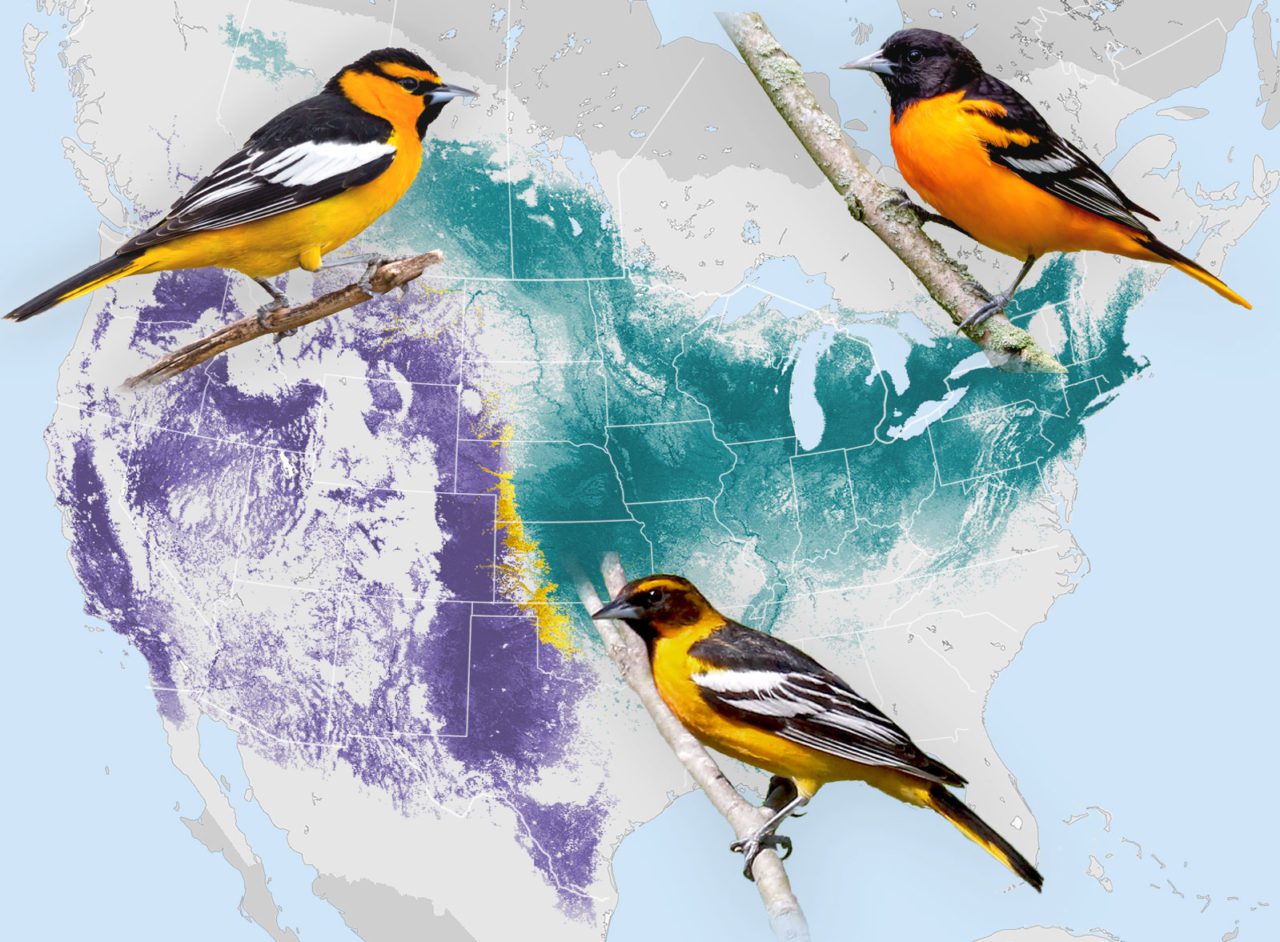
The first scientist to document “oddly plumaged orioles” in the Great Plains was George Miksch Sutton, who collected oriole specimens in western Oklahoma in 1937 that showed a mix of Bullock’s and Baltimore Oriole traits in their plumage. When Sutton published his findings in the ornithology journal The Auk, he included a beautiful full-color illustration showing what was clearly a male Baltimore Oriole, with an all-black head and a narrow white wingbar; and a bird that was clearly a Bullock’s Oriole, with a black eyeline on a mostly orange face and a big white wing patch. In between those two birds Sutton showed four other orioles that displayed a spectrum of intermediates between Baltimore and Bullock’s, which he speculated could be hybrids.
Additional research over the following decades showed that Sutton was right. Most notably, Cornell University professor Charles Sibley (no relation to the famous field guide author) oversaw a series of field studies between 1954 and 1957 across the entire hybrid zone between the two species. Sibley and his students and colleagues collected more than 600 oriole specimens from Texas to South Dakota, with most coming from along the Platte River in Colorado and Nebraska. By examining each specimen’s plumage in detail and rating where each aspect of their appearance fell on the spectrum from Baltimore to Bullock’s, they concluded that hybrid orioles were common in this zone. This, they reasoned, must mean that there were no barriers to hybridization when Baltimore and Bullock’s Orioles have the opportunity to breed. Largely because of Sibley’s finding that the species interbred where they overlapped along the Platte, the two species were officially lumped as the Northern Oriole in 1973.

Baltimore and Bullock’s Orioles were just two of many bird species caught in the “great lumping” of the mid-20th century, the result of renowned evolutionary biologist Ernst Mayr’s biological species concept. Mayr proposed that species could be defined as “groups of interbreeding natural populations that are reproductively isolated from other such groups,” emphasizing interbreeding (or the lack thereof) over appearance. Based on these criteria, many species of birds were lumped; for example, the Dark-eyed Junco is a conglomerate of five former junco species that exhibit plumage differences, but interbreed freely wherever they come into contact.
Not everyone was satisfied that lumping was the right call for orioles, however. From the start, some ornithologists argued that to really settle the matter, they needed a better understanding of the degree of blending between the two populations. Indeed, further studies showed that the oriole hybrid zone was surprisingly narrow. Instead of a broad, fuzzy gradient, an oriole hybridization map of North America shows a sharp transition from Bullock’s-type birds to Baltimore-type birds—with only a slender band of hybrids down the middle. In the 1980s, primitive genetic techniques suggested that outside the hybrid zone there was almost no evidence of what geneticists call introgression, or the blending of genetic information from one species into the other. Based on these developments, the American Ornithologists’ Union decided in 1995 to reverse their earlier decision, declaring the Bullock’s Oriole and the Baltimore Oriole to be separate species once more.
As it turned out, Bullock’s and Baltimores aren’t even all that closely related. An oriole evolutionary tree based on mitochondrial DNA, published in 1998, showed that Baltimore and Bullock’s Orioles are not each other’s closest evolutionary relatives. Instead, the Baltimore Oriole’s genetic sister species (the species with which it shares the most recent common ancestor) is the Black-backed Oriole, found only in Mexico. The Bullock’s Oriole’s sister species may be another Mexican oriole, the Streak-backed Oriole.
The latest chapter in the story of studying these orioles and their hybrids began in 2016, when Cornell Lab scientists set out for 21st-century expeditions along the Platte River. Over the course of three years, they revisited the sites in Colorado and Nebraska originally studied by Charles Sibley 60 years earlier. Knocking on farmers’ doors and camping under cottonwoods, they sampled a brand-new set of specimens.
“That new sampling allows us to compare where the hybrid zone is now to where it was half a century ago, and to discover the genes that make these species look different from one another,” says Irby Lovette, director of the Cornell Lab’s Fuller Evolutionary Biology Program.
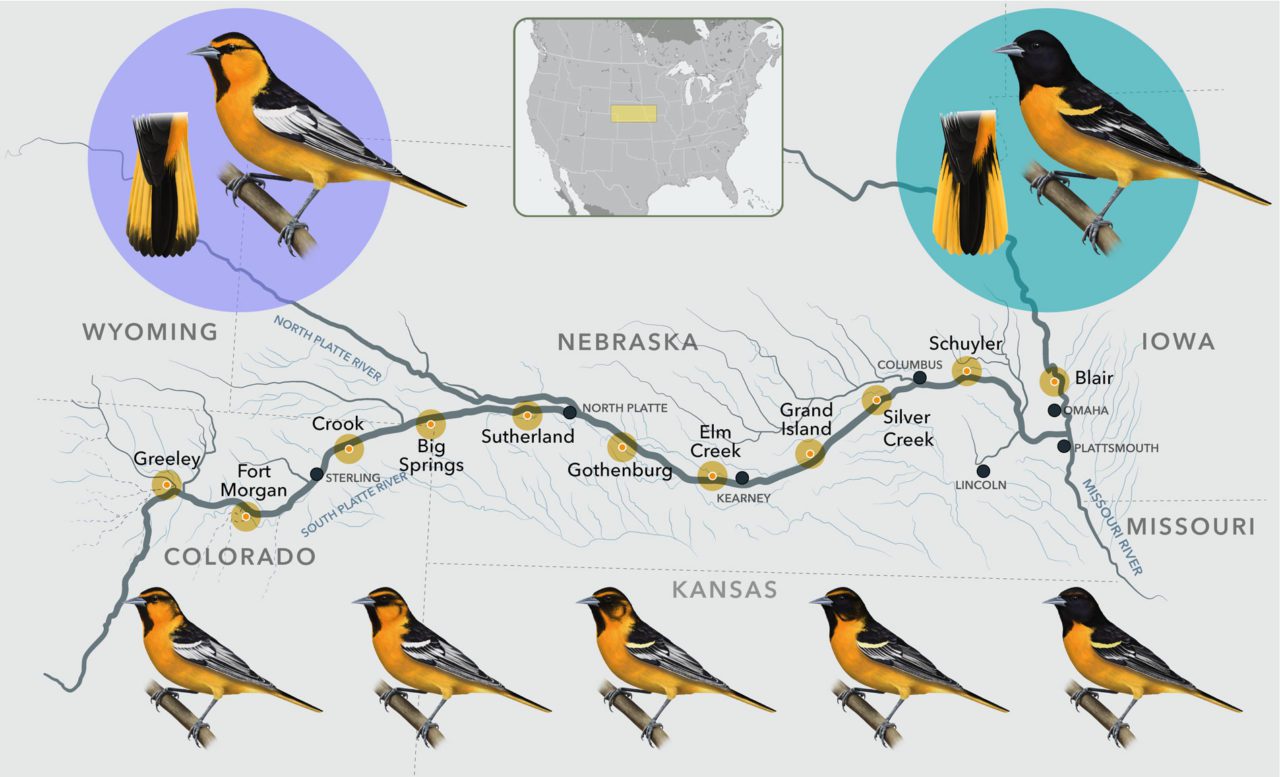
The first analysis of those birds, published in The Auk in 2020, was led by Cornell Lab scientist Jennifer Walsh, an expert on avian genomics. Walsh’s work showed that the center of the hybrid zone had shifted, moving west by roughly 50 kilometers since it was first studied in detail in the 1950s. In the genomes of Baltimore Orioles living where the hybrid zone used to be, Walsh could see what she calls a “comet tail” of introgression—a hidden signature of Bullock’s Oriole genes that remained in the Baltimore Oriole population even as Bullock’s Orioles themselves retreated westward. Even though it didn’t show in their external appearance, Baltimore Orioles east of the current center of the hybrid zone had evidence of past interbreeding in their DNA, similar to how some modern humans still carry small remnants of Neanderthal genes from interbreeding in the distant past.
The reasons for the hybrid zone’s shift west aren’t clear. Vanya Rohwer—the curator of birds and mammals at the Cornell University Museum of Vertebrates—led the effort to retrace the path of the Sibley expedition and document the current status of hybrid orioles along the Platte River. Rohwer says that more cottonwood trees have filled in and expanded the habitat corridor along the Platte since Sibley’s day, possibly allowing Baltimore Orioles to push farther west—and thus, the Baltimore–Bullock’s hybrid occurrences moved west as well.
Genetic analysis of the new set of specimens also confirmed that hybridization, though common, was still limited to a narrow region. Outside of that 50-kilometer hybridization belt there was little current genetic mixing. It seemed that something was keeping the two species separate, preventing them from mingling so much over time that they collapsed back into one species.
When the hybrid-zone research was published in The Auk in 2020, a Cornell Lab press release on the study declared that “Hybridization is a dead end” for Baltimore and Bullock’s Orioles— seemingly the final word on whether the orioles were one species or two. But Walsh and her colleagues weren’t done studying the orioles of the Platte River. In fact, they were just getting started, because now they wanted to dig deeper into why Baltimore and Bullock’s Orioles remain separated.
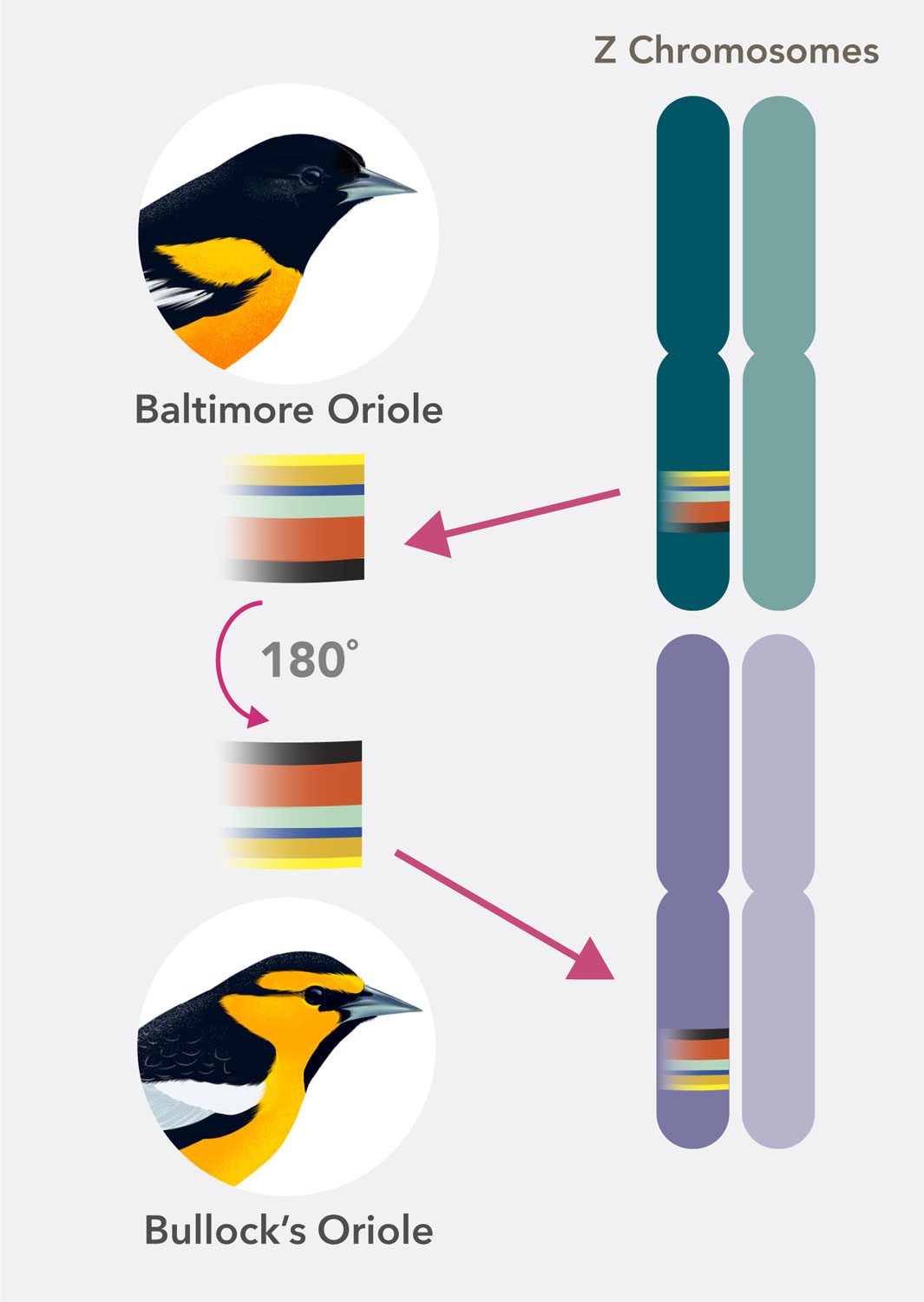
Jennifer Walsh used to spend her days trekking through thigh-high muck in tidal marshes along the Atlantic Coast to collect data on Saltmarsh Sparrows. From 2015 to 2020, Walsh worked as a Cornell Lab postdoctoral fellow on research that identified the sparrow’s adaptations to nesting in a regularly flooded saltmarsh—and how sea-level rise threatened to push the bird into extinction. (See Sea Change: As Sea Levels Rise, Can Saltmarshes Be Saved?, Spring 2020.)
Now a research associate in the Cornell Lab’s Center for Biodiversity Studies, Walsh today works long hours in a laboratory, studying the genes that underlie the phenotypic (or physical) traits in birds. Genomics research allows her to study any species in the Cornell Lab’s collection of 60,000 specimens: “If it has a genome, and it’s a bird, I’m game,” she says.
Walsh’s 2020 research on the new oriole specimens from the Platte River region used a genomic technique called reduced-representation sequencing— which essentially entails comparing thousands of points on the genome at random, and analyzing how two species are similar to or different from each other.
“Often we used reduced-representation sequencing approaches to get an idea of population structure—like, how are these species different?” says Walsh. But “you can’t really get down to, why are they different, and what are the implications of that for their evolution?”
Now, however, Walsh and her colleagues have taken the next big step. In 2021 Walsh’s team sequenced the entire genomes of 60 orioles (pure Baltimore and Bullock’s Orioles as well as hybrids), plus some selected interesting bits from the genomes of over 300 other hybrid orioles in the Cornell collection. All of the birds in their study were males—the plumage of the males of the two species is easier to differentiate, and comparing specimens with the same sex chromosomes makes genetic analysis simpler.
Whereas the 2020 study of orioles examined thousands of points of potential variation among the birds’ genes, this new line of research looked at millions of points across the entire genomes, requiring months of supercomputer time to complete. After all that genome searching, the picture that emerged of how the two oriole species differ was, as Walsh puts it, “complicated.” Even more complicated than she expected.
A prior, somewhat similar genome comparison between two hybridizing bird species yielded a far simpler result. In 2016, then-Cornell Lab postdoctoral researchers Scott Taylor and David Toews sequenced the genomes of Blue-winged and Golden-winged Warblers and found that they differed at only six spots in their genomes, four of which were clearly related to differences in plumage patterns. The scientists could directly tie specific genome regions to the throat color, or body color, of Blue-wings and Golden-wings and two hybrids in between (the so-called Brewster’s and Lawrence’s Warbler forms; see Mixed-wing Warblers, Summer 2016).
Supergenes and Chromosomal Inversions
Walsh, in comparison, found thousands of locations in the genome where Baltimores and Bullock’s were sharply different, including an entire chunk of the Z chromosome (the male sex chromosome in birds) where hundreds of genes were flipped in one species versus the other; picture pulling out a set of genes from a Baltimore Oriole, rotating it 180 degrees, and reinserting it into the genome of a Bullock’s Oriole in reverse order. Called a chromosomal inversion, the genes that are flipped in the orioles are involved in plumage coloration. Specifically, they’re genes that play roles in melanogenesis, the production of dark pigments.
“[In the past] we’ve looked at hybrid zones between closely related species, and we’ve seen these fairly simple stories and simple landscapes,” says Walsh. “But the more diverged that species become, the more of these [differences] accumulate over time.” According to Walsh, the genomes of the two orioles show several regions under selection, interacting in complex ways to maintain two distinct species. It’s not as simple as a few genes linked to plumage.
More On Hybrids
Although complex, the genetic differences between the two species are so stark that Walsh is convinced there’s more going on than just some yet-to-be-identified disadvantage leading to natural selection against hybrids. Contrary to field observations that suggested the two species interbreed freely, she speculates that there must also be something deterring Baltimore and Bullock’s Orioles from mating with each other. It obviously happens sometimes, or there would be no hybrids, but maybe only “when there’s none of your [own] species around,” as she puts it.
According to Marcella Baiz, a postdoctoral researcher at Penn State who has worked on Blue-winged and Golden-winged Warbler genetics, Walsh’s oriole research provides a look at the later stages of speciation.
“By definition, species that are hybridizing aren’t completely reproductively isolated from each other. They’re still in the process of speciation, so we can get a preview of that process while it’s still ongoing and could play out in different ways,” Baiz says.
The fact that the Baltimore and Bullock’s Orioles are not collapsing into a single species shows that “in this system, the barriers that keep the species separate seem to be really strong,” she says.
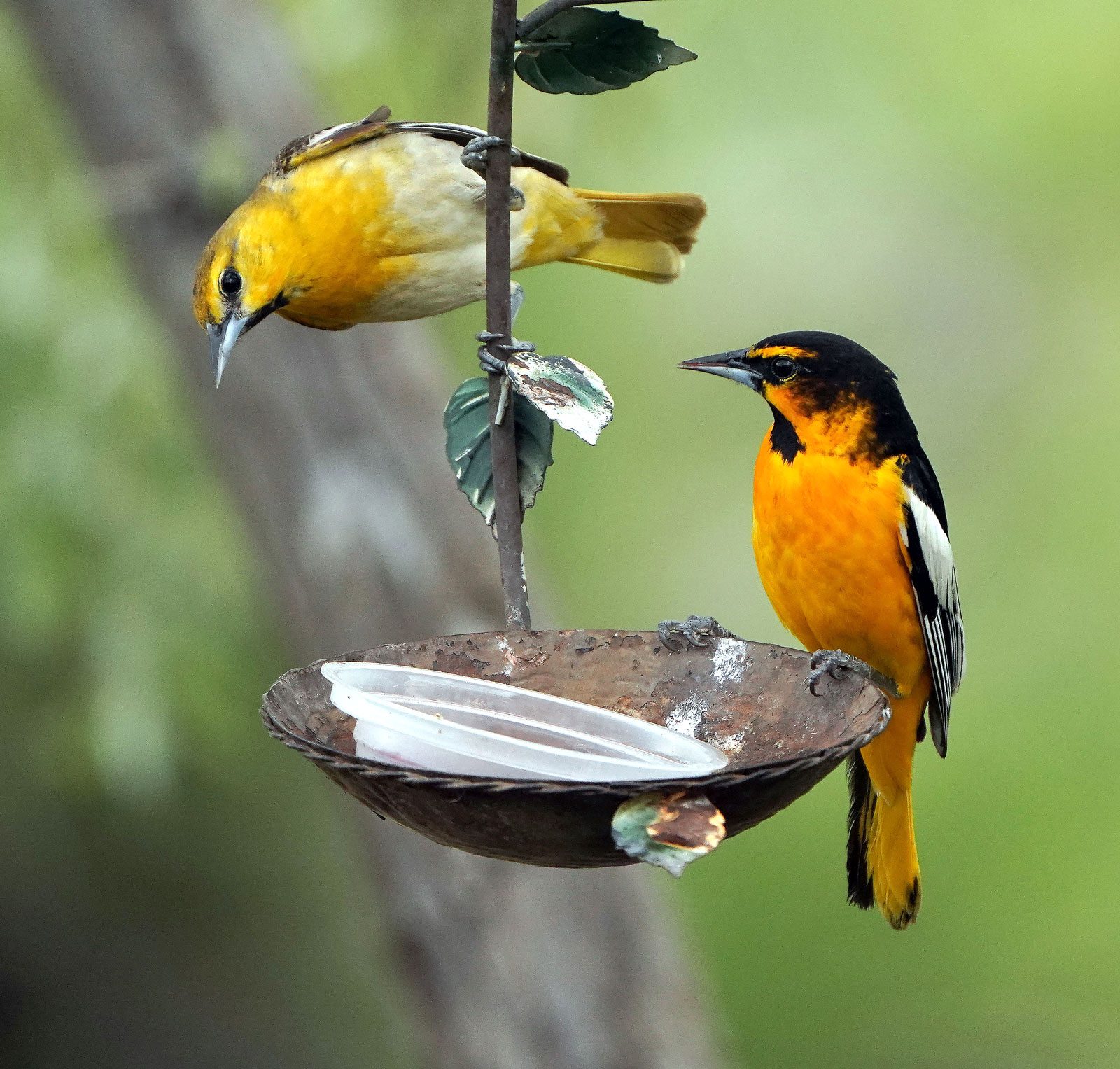
Walsh and her Cornell colleagues are not exactly sure what is happening in nature that drives the species divide between the two orioles—at least not yet. If a Baltimore Oriole is hesitant to mate with a Bullock’s Oriole, and vice versa—and the birds are making those decisions based on plumage—that might help account for the selective pressure on genes involved in melanin production. But tantalizingly, the region of the Z chromosome that’s flipped between the two species also includes genes for visual perception. So that choosiness could stem not only from how the birds actually look, but also, literally, from how they see each other.
The scientists are also still speculating about the forces at work that make hybrids less successful than their parents—in other words, the why of that statement that oriole hybridization is a dead end. Baltimore and Bullock’s Orioles follow different schedules for molting their feathers and migrating; a hybrid whose genetic programming is mixed up between the two oriole genomes may find itself in an inhospitable place come molting time. The two species also have differing tolerance for hot, dry environments—a hybrid could end up trying to breed in a habitat that it doesn’t have the genes to handle.
Another open question: Have humans affected the way these two species interact? It’s possible that before European colonization, when prairie fires and bison roamed freely, there were far fewer cottonwoods growing along the rivers of the Great Plains—meaning fewer wooded thoroughfares within which forest birds from the East and West could intermingle. Maybe Bullock’s and Baltimore Orioles came back into contact only relatively recently as European settlers largely removed fire and bison from the environment.
Charles Sibley probably could not have imagined, as he collected birds along the Platte River in 1954, that the specimens he was bringing back to Ithaca, New York, might one day have their entire genomes sequenced. James Watson, Francis Crick, and Rosalind Franklin had only discovered the structure of DNA a few years earlier. But using the Sibley specimens in the Cornell collection, Walsh and her colleagues may be able to see how the genes of birds in the hybrid zone have changed over time. Vicens Vila-Coury, an undergraduate Cornell student working with Walsh, has already shaved tiny skin samples from 200 of Sibley’s oriole specimens with the intent of analyzing their genomes and comparing them to the modern birds. It’s only a matter of time until Walsh and her team will be able to analyze genetic changes in the Platte River orioles across time as well as space.
“As species diverge and recombine, the process is really complex in some cases like these orioles, and in others, it’s super simple. You can’t just look at the birds and know for sure whether they are complicated or simple in their histories,” says Irby Lovette. “Maybe naively, we originally thought that going in with tools like whole-genome sequencing, we could get all the answers, and everything would follow the same model.”
But now, Lovette says, scientists can see that every hybrid zone is a test case among the many different pathways to speciation.
While Cornell ornithologists in Upstate New York continue to puzzle over the nucleotides that make birds what they are—and how species fissure and fuse—this spring orioles will return from migration to a special stretch of the Platte River, just as they have for centuries. There they’ll forage for food, sing, mate (sometimes with the other species), build nests, and raise young—in short, do what orioles do.
And in doing so, they’ll continue to play out this scientific riddle of speciation, just by being themselves.
Rebecca Heisman is a science writer based in Walla Walla, Washington. Her first book, Flight Paths, about the amazing technology behind modern studies of bird migration, will be published by HarperCollins in 2023. Check out her website, and find her on Twitter and Instagram as @r_heisman.

All About Birds
is a free resource
Available for everyone,
funded by donors like you
American Kestrel by Blair Dudeck / Macaulay Library
